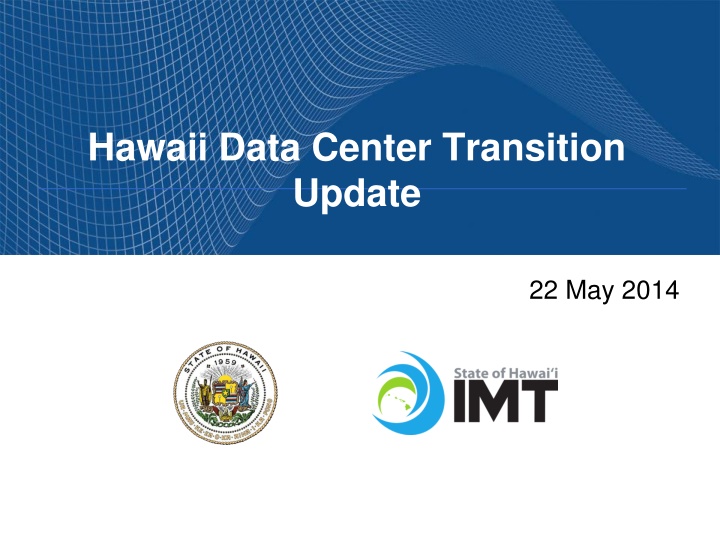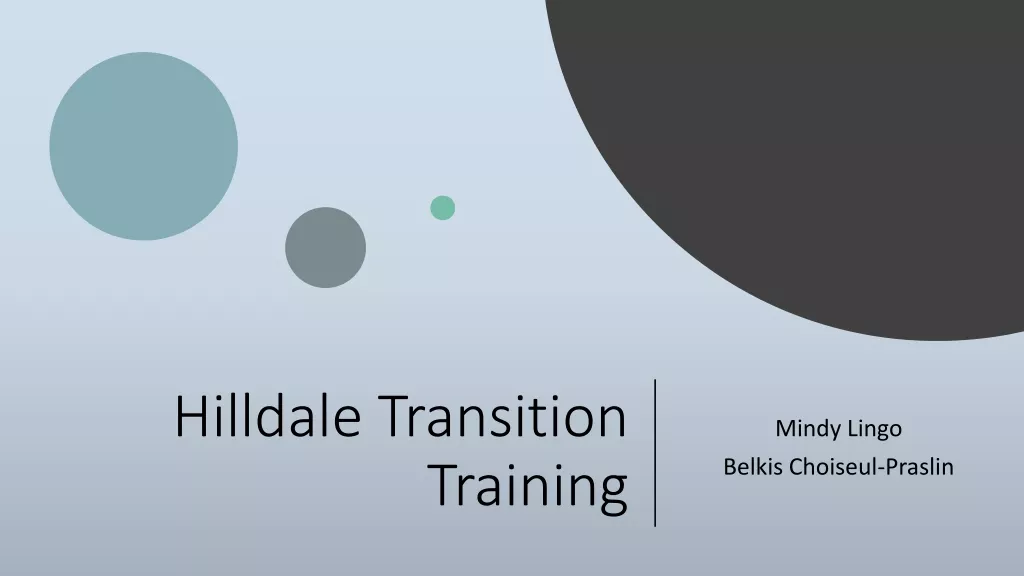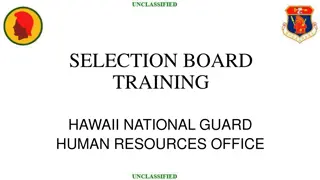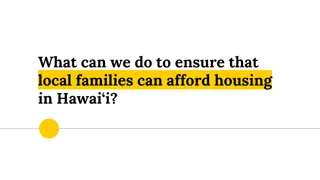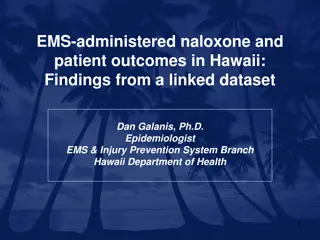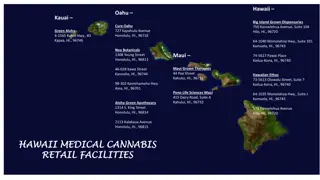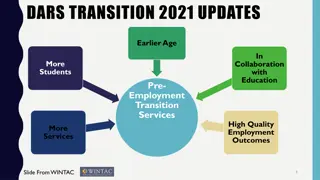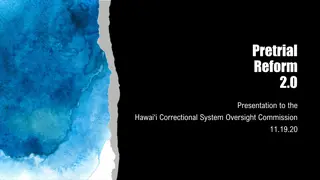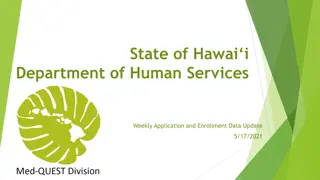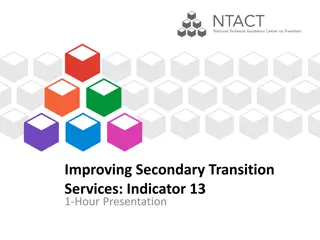Hawaii Data Center Transition Update
State of Hawaii's data center transition update for May 2014 includes current and planned enhancements in IT infrastructure, disaster recovery strategies, virtualization efforts, and future roles and responsibilities. The transition involves moving IT assets, establishing a private cloud with standardized service offerings, and outlining customer responsibilities for maintenance and patching. Tactical moves and strategic plans aim to optimize network connectivity, resource provisioning, and governance within the state's IT ecosystem.
Download Presentation

Please find below an Image/Link to download the presentation.
The content on the website is provided AS IS for your information and personal use only. It may not be sold, licensed, or shared on other websites without obtaining consent from the author.If you encounter any issues during the download, it is possible that the publisher has removed the file from their server.
You are allowed to download the files provided on this website for personal or commercial use, subject to the condition that they are used lawfully. All files are the property of their respective owners.
The content on the website is provided AS IS for your information and personal use only. It may not be sold, licensed, or shared on other websites without obtaining consent from the author.
E N D
Presentation Transcript
Hawaii Data Center Transition Update 22 May 2014
A Quick Refresher Current State Environment State IT assets spread across 27+ departmental and ICSD data centers on Oahu Permanent State Most State system housed in highly robust Tier 3 data center located away from likely disaster zones. Tactical Enhancements High Speed connectivity between DR Fortress, Systemmetrics, MRTC and Kalanimoku Judiciary Network Enhancements DOE Primary DC (Oahu) Secondary DC (Maui) Satellite DC s on NI s Kalanimoku Building Ready by July 2014 MAUI DR Fortress System Metrics MRTC Overflow Capacity for Kalanimoku and Dept DC s Relocating Network Hub The tactical moves provide some capacity and disaster recovery capabilities, affording minor risk mitigation until the permanent strategy can be implemented Building the Virtualized environment at Kalanimoku with disaster recovery capability at DR Fortress Contracting with the two island co-location facilities to provide overflow capacity in light of future system needs Refurbishing Maui Research Technology Center to use for rudimentary disaster recovery Enhance network connectivity with co-location providers and MRTC
Planned Attributes of Hawaiis Private Cloud Self-Service Interface Portal (GUI or API) Service-level requirements, actuals Operational Process Automation Incident & Problem management Change management Provisioning and configuration management Performance management and optimization Automation of Service Delivery Service provider Usage management and chargeback Automation of Resources Provisioning Migration/motion Allocation/de-allocation Government Private Cloud Resource Virtualization Virtual servers, operating systems, storage and network,
Hawaiis Private Cloud Services Once fully implemented, Hawaii s Government Private Cloud will provide a standardized, self-service shopping cart experience Bundle Size CPU Memory (GB) Storage Small 2 Core 4 GB 90 GB Medium 4 Core 8 GB 90 GB Large 8 Core 16 GB 90 GB Extra Large 16 Core 32 GB 90 GB Windows 2012 6.x
Future Roles & Responsibilities Customer Provided X OIMT/ICSD Provided Maintenance of Customer Application Environment Disaster Recovery Patching will only be done for customers that have standardized (i.e. Windows 2012/Redhat 6.x) services Customers who conduct P2V migrations to the virtual environment will be required to perform the above function X Storage X Firewall X SAN/LAN Switches X Virtual Servers X Network Management X Racks/Cabling X Cooling X Physical Space X
Where are We Now? Real-Time Infrastructure We are here Sprawled Virtualized Automated Cloud- enabled Optimization Availability Workloads Data Resources Identities Provisioning Asset, power costs down, flexibility up Service levels and agility up
The GPC Project Plan - Crawl, Walk, Run Step 1: Build virtualized infrastructure at Kalanimoku (KB) as the primary location and establish back up capability at DR Fortress (DRF) Step 2: Begin migrating critical department workloads over to the virtual environment and alleviate risk of failures Step 3: Establish true Cloud services with self service, service catalog and chargebacks, Continue migrations and stand up of new VM s for departments Establish self-service capability Establish service catalog and chargebacks to departments DR Fortress will become primary location, with Maui becoming backup/redundant location Develop Service Management processes and SLA s Develop process for physical-to- virtual (P2V) and virtual-to-virtual (V2V) migrations Develop applications prioritization and Migration Plan Conduct Migrations Stand up new Windows 2012 & Redhat 6.x VMs as requested Establish some disaster recovery capability at DR Fortress Install IBM Flex architecture in KB & DRF - COMPLETE Conduct pilot migrations Stand up new Windows 2012 & Redhat 6.x VMs as requested - COMPLETE Begin department-by- department needs assessment for potential use of Cloud - STARTED April-June 2014 June-December 2014 2015 -
Departmental Outreach and Collaboration We ve already started meeting with Departments to identify initial requirements Step 1: email the OIMT Cloud Team and set up a meeting Step 2: Complete and send the Cloud Scope Capture Sheet Step 3: Meet with the Cloud Team and determine best approach for migrating workloads into the virtual environment Departments that have completed Requirements Meetings Public Safety Department of Human Resources Development Hawaii Criminal Justice Data Center Attorney General Juvenile Justice Information System Attorney General Legal Services Division Governor s Office Agriculture Accounting & General Services Commerce & Consumer Affairs State Archives
We want to hear from you oimt.cloud@hawaii.gov
